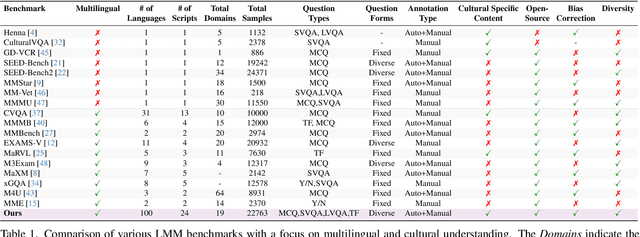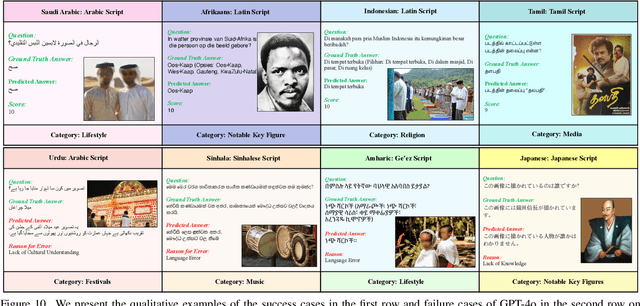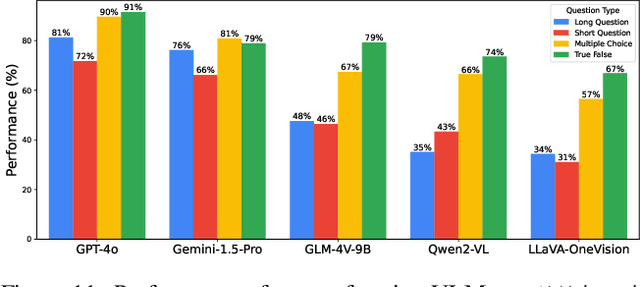Mihail Mihaylov
All Languages Matter: Evaluating LMMs on Culturally Diverse 100 Languages
Nov 25, 2024



Abstract:Existing Large Multimodal Models (LMMs) generally focus on only a few regions and languages. As LMMs continue to improve, it is increasingly important to ensure they understand cultural contexts, respect local sensitivities, and support low-resource languages, all while effectively integrating corresponding visual cues. In pursuit of culturally diverse global multimodal models, our proposed All Languages Matter Benchmark (ALM-bench) represents the largest and most comprehensive effort to date for evaluating LMMs across 100 languages. ALM-bench challenges existing models by testing their ability to understand and reason about culturally diverse images paired with text in various languages, including many low-resource languages traditionally underrepresented in LMM research. The benchmark offers a robust and nuanced evaluation framework featuring various question formats, including true/false, multiple choice, and open-ended questions, which are further divided into short and long-answer categories. ALM-bench design ensures a comprehensive assessment of a model's ability to handle varied levels of difficulty in visual and linguistic reasoning. To capture the rich tapestry of global cultures, ALM-bench carefully curates content from 13 distinct cultural aspects, ranging from traditions and rituals to famous personalities and celebrations. Through this, ALM-bench not only provides a rigorous testing ground for state-of-the-art open and closed-source LMMs but also highlights the importance of cultural and linguistic inclusivity, encouraging the development of models that can serve diverse global populations effectively. Our benchmark is publicly available.
Extract More from Less: Efficient Fine-Grained Visual Recognition in Low-Data Regimes
Jun 28, 2024Abstract:The emerging task of fine-grained image classification in low-data regimes assumes the presence of low inter-class variance and large intra-class variation along with a highly limited amount of training samples per class. However, traditional ways of separately dealing with fine-grained categorisation and extremely scarce data may be inefficient under both these harsh conditions presented together. In this paper, we present a novel framework, called AD-Net, aiming to enhance deep neural network performance on this challenge by leveraging the power of Augmentation and Distillation techniques. Specifically, our approach is designed to refine learned features through self-distillation on augmented samples, mitigating harmful overfitting. We conduct comprehensive experiments on popular fine-grained image classification benchmarks where our AD-Net demonstrates consistent improvement over traditional fine-tuning and state-of-the-art low-data techniques. Remarkably, with the smallest data available, our framework shows an outstanding relative accuracy increase of up to 45 % compared to standard ResNet-50 and up to 27 % compared to the closest SOTA runner-up. We emphasise that our approach is practically architecture-independent and adds zero extra cost at inference time. Additionally, we provide an extensive study on the impact of every framework's component, highlighting the importance of each in achieving optimal performance. Source code and trained models are publicly available at github.com/demidovd98/fgic_lowd.
CVQA: Culturally-diverse Multilingual Visual Question Answering Benchmark
Jun 10, 2024



Abstract:Visual Question Answering (VQA) is an important task in multimodal AI, and it is often used to test the ability of vision-language models to understand and reason on knowledge present in both visual and textual data. However, most of the current VQA models use datasets that are primarily focused on English and a few major world languages, with images that are typically Western-centric. While recent efforts have tried to increase the number of languages covered on VQA datasets, they still lack diversity in low-resource languages. More importantly, although these datasets often extend their linguistic range via translation or some other approaches, they usually keep images the same, resulting in narrow cultural representation. To address these limitations, we construct CVQA, a new Culturally-diverse multilingual Visual Question Answering benchmark, designed to cover a rich set of languages and cultures, where we engage native speakers and cultural experts in the data collection process. As a result, CVQA includes culturally-driven images and questions from across 28 countries on four continents, covering 26 languages with 11 scripts, providing a total of 9k questions. We then benchmark several Multimodal Large Language Models (MLLMs) on CVQA, and show that the dataset is challenging for the current state-of-the-art models. This benchmark can serve as a probing evaluation suite for assessing the cultural capability and bias of multimodal models and hopefully encourage more research efforts toward increasing cultural awareness and linguistic diversity in this field.
 Add to Chrome
Add to Chrome Add to Firefox
Add to Firefox Add to Edge
Add to Edge